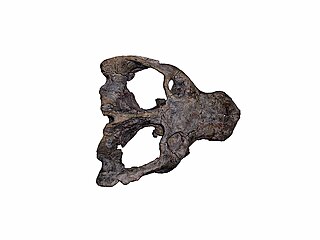Saturnalia is an extinct genus of basal sauropodomorph dinosaur known from the Late Triassic Santa Maria Formation of Rio Grande do Sul, southern Brazil and possibly the Pebbly Arkose Formation, Zimbabwe.

The Federal University of Santa Maria is a Brazilian public university located in Santa Maria, in the state of Rio Grande do Sul, funded by the federal government of Brazil. It was founded in 1960, by Professor José Mariano da Rocha Filho. Its campuses span over 1,837.72 ha, with a total of 386,968 m² of buildings and 28,307 students.

The Paleontological Site Arroio Cancela is located within the city of Santa Maria, a municipality of Rio Grande do Sul, the southernmost state of Brazil. The site is situated in the neighbourhood Nossa Senhora de Lourdes at an altitude of 107 metres above sea level. The fossils have been discovered within the sediments of the Santa Maria Formation, they are vertebrates from the Triassic period and are about 225 million years old.

Paleontological Site Jazigo Cinco is located in the city of Santa Maria, Rio Grande do Sul, Brazil. And belongs to Santa Maria Formation. It is located in the neighborhood Kilometro 3 near Castelinho, is to 2.7 kilometers away from the Paleontological Site Arroio Cancela. It belongs to UFSM and is a center of research. It is the place where he was collecting the Staurikosaurus, the first Brazilian dinosaur. Site belongs to the region paleorrota.

The Sanga da Alemoa paleontological site is located in the city of Santa Maria, Rio Grande do Sul, in Brazil. It belongs to the Caturrita Formation and the Santa Maria Formation. It is located in the neighborhood of Castelinho. The site belongs to the paleorrota region.

The Palaeontological Site Chiniquá is located in the Brazilian municipality of São Pedro do Sul, Rio Grande do Sul, along highway BR-287, about 70 kilometers west of the city of Santa Maria. The site occupies an area of about 250 hectares and is part of the geopark of paleorrota. It yielded fossils of Middle Triassic (Ladinian) age.

The Educational Museum Gama D'Eça is located in the center of Santa Maria city, Rio Grande do Sul, Brazil. The current headquarters of the museum, located at Rua do Acamapamento Street, 81. The schedule of visits to the Museum is from Monday to Friday from 8am to 12am and from 1pm to 5pm.

The Museum Vicente Pallotti is located on Avenida Presidente Vargas, 115 in Santa Maria, Rio Grande do Sul, Brazil. It is located in the same complex Palotina College (FAPAS). Visits need to be scheduled in advance.

The Aristides Carlos Rodrigues Museum is located at Avenue Pereira Rego, 1000, in the town of Candelária, in the state of Rio Grande do Sul, Brazil. It is a museum of Geopark of Paleorrota with information on the region. It was inaugurated in July 2001.

Daniel Cargnin (1930–2002) was a Brazilian priest and amateur paleontologist born in Nova Palma, in the state of Rio Grande do Sul, Brazil, in 1930. He died in 2002, and at his request was buried in the town of Mata.
The Institute of Geosciences is a unit of instruction of the Federal University of Rio Grande do Sul (UFRGS). It includes the undergraduate courses of Geography, Geomatics Engineering, Geology. It has a department of study of vertebrate paleontology which has made great contributions to the geopark of Paleorrota.
Protuberum is an extinct genus of traversodontid cynodonts known from a single species Protuberum cabralense, from the Middle Triassic of Brazil.

The Sanga do Cabral Formation is an Early Triassic sedimentary rock formation found in Rio Grande do Sul, Brazil.
Cerritosaurus is a genus of proterochampsid archosauromorph from the Late Triassic. It has been found in the Santa Maria Formation, in the Geopark of Paleorrota, Brazil. It is represented by one species.
Guilherme Rau (?–1953) immigrated to Santa Maria, Rio Grande do Sul, Brazil from Germany in 1900. An ophthalmologist, from 1915 to 1917 he helped with the Geological Survey of Berlin's excavation of 200 fossil at the Paleontological Site Sanga of Alemoa. He also contributed considerably to the Geopark of Paleorrota and taught Botany at the Faculty of Pharmacy of the city in the years 1934 and 1935.
João Guilherme Fischer, also known as Jango Fischer was a Brazilian diplomat and scientist.
Atílio Munari was born in Santa Maria, Rio Grande do Sul, Brazil.
Vicentino Prestes de Almeida, was a Brazilian paleontologist. He died on October 28, 1954, in São Pedro do Sul.

Rudolf Stahlecker was a German geologist and biology teacher.

Ginkgoites is a genus that refers to extinct plants belonging to Ginkgoaceae. Fossils of these plants have been found around the globe during the Triassic, Jurassic and Cretaceous. The name was created as a form genus in 1919 by Albert Seward who stated: "I ... propose to employ the name Ginkgoites for leaves that it is believed belong either to plants generically identical with Ginkgo or to very closely allied types".














